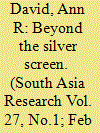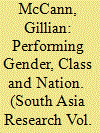| Srl | Item |
| 1 |
ID:
077208


|
|
|
|
|
| Publication |
2007.
|
| Summary/Abstract |
This article first highlights the relative paucity of literature on South Asian dance and provides a brief overview of existing material. It then examines particularly the influence of filmi or Bollywood dance on South Asian dance practices in the UK. It locates film dance within the Bollywood genre, noting its recent acceptance as a new form of popular culture and its attractions for the younger generation of British Asians. The place of dance in Hindi films is analysed and discussed briefly to con-textualise the relationship between such film dances and South Asian dance practices in Britain. Using evidence from fieldwork gathered in Leicester and London amongst dance teachers and students of South Asian dance, the article questions notions of identity, authenticity, tradition and the changing nature of dance transmission as Bollywood forms grow in popularity.
|
|
|
|
|
|
|
|
|
|
|
|
|
|
|
|
| 2 |
ID:
170180


|
|
|
|
|
| Summary/Abstract |
Rukmini Devi Arundale, herself a choreographer and dancer, is considered one of the key figures in re-creating Bharatanatyam. Through her utopian arts colony, Kalakshetra, started during the movement towards Indian independence, she taught what she deemed to be a classical, religious and aesthetically pleasing form of dance. Her rejection of what she termed vulgarity and commercialism in dance reflects her Theosophical worldviews and her class position in a rapidly changing South India. The article examines the ways in which her understanding of Bharatanatyam developed in the context of contested forms of nationalism as a gender regime that contributed to creating proper middle-class, Hindu and Indian subjects. It also examines the impacts of this form of cultural heritage relating to gender, culture and nationalism in today’s globalised South Asian dance scenario.
|
|
|
|
|
|
|
|
|
|
|
|
|
|
|
|